|
KHAJU BRIDGE
|
TAKEO KAMIYA
|
KHAJU BRIDGE
|
TAKEO KAMIYA
|
Although there are no great rivers in Iran owing to the fact most of its territory is desert, Isfahan in the Kavir Desert is on the Zayandeh River, which originates in the Zagros Mountains, and supplies water for the city. The river does not however reach the sea, disappearing at about 100 km east of the city in the Gavkhouni Marsh.
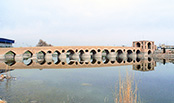 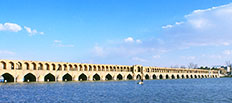 Shahrestan Bridge and Si-o-Seh Bridge (Allahverdi Khan Bridge)
Thus, in order to conveniently connect the northern and southern parts of Isfahan separated by the river, new bridges were needed. Though naturally there were some bridges since the age of the Sassanid Dynasty (226-651), it was in the age of the Safavid Dynasty (1502-1736) that they were reconstructed far more strongly and beautifully.
The civilization who most highly developed the technology of bridge construction was the ancient Roman Empire. The reason that the bridges of its Hellenistic civilization in various places are still in use is that they were constructed through the structure of stable arches. The functions of Persian bridges were not only transportation of people and goods from one side to another. Since a river might be the sole source of water in a desert climate, it was necessary to bring water to a city and to the irrigation canals of nearby fields, regulating the flow of river water. Many Persian bridges thus carried out such roles as dams and barrages.
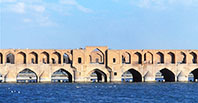 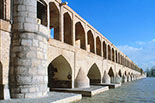 The Bridge of 33 Arches (Allahverdi Khan Bridge) The new city area of Isfahan constructed by Shah Abbas I has a great boulevard stretching straight from south to north. Along this garden-like boulevard as wide as 47m with abundant trees, many splendid Chaharbaghs (four quartered gardens) were constructed; hence the boulevard has been also called the Chahar Bagh Street. As this street crosses the Zayandeh River at its broadest spot, its bridge reaches 295m, the longest in Isfahan. After the name of a general who served the Shah and constructed this bridge, it was designated as Allahverdy Khan Bridge, and yet it is also called the Si-o-Seh Pol, literally meaning the Bridge of 33 Arches, because of its continuous 33 robust pier arches. Already as early as the 17th century, the bridge separated pedestrian lanes from a central vehicle lane, and furthermore covered the pedestrian lanes on both sides with roofs for protection against the sun. Since its structural system is to build three continuous arches over each large pier arch, its whole appearance is quite spectacular, lining up in a straight line about 100 arches in total. And these pedestrian lanes function not only as walking space but also as a resting place for enjoining the scenery of the river and town.
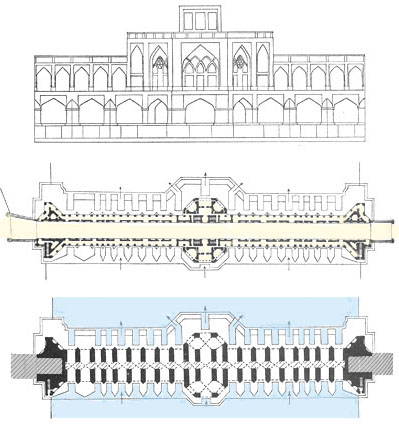
This character was developed further in the Khaju Bridge that was constructed by Shah Abbas II in 1650 a little downstream. Here both the lower part near the water level and the pedestrian lane separated from the vehicle lane on the upper part have protruding hexagonal spaces at the center and both ends as observation platforms, where people could enjoy views and chats, and the Shah occasionally used the whole bridge as a feast venue. The Khaju Bridge lies in a row of such compound functions like the Old London Bridge and Ponte Vecchio in Florence. Despite having no shops, the Khaju Bridge had Chay Hanes (Tea Houses) on the lower level and at both feet of the bridge, which are used still now, functioning as a civic spot for amusement. The decorations with glazed tiles on walls over the arches also indicate that this was not only intended to be a practical bridge but also a composite facility of traffic and pleasure.
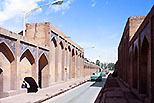 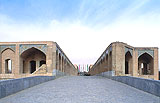 The Khaju Bridge also functions as a dam, incorporating equipment to adjust the quantity of water flow. Though its external view, consisting of a series of brick arches, is almost the same as those of caravanserais and madrasas, its appearance with spurting water narrowed by its piers with its sprightly sound give the townscape a fascinating dynamic view.
(In "Architecture of Islam" 2006) E-mail to: kamiya@t.email.ne.jp
|